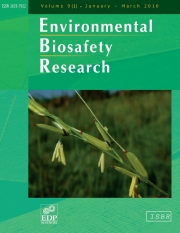Crossref Citations
This article has been cited by the following publications. This list is generated based on data provided by
Crossref.
Raybould, Alan
2007.
Ecological versus ecotoxicological methods for assessing the environmental risks of transgenic crops.
Plant Science,
Vol. 173,
Issue. 6,
p.
589.
Romeis, J.
Waldburger, M.
Streckeisen, Ph.
Hogervorst, P. A. M.
Keller, B.
Winzeler, M.
and
Bigler, F.
2007.
Performance of transgenic spring wheat plants and effects on non‐target organisms under glasshouse and semi‐field conditions.
Journal of Applied Entomology,
Vol. 131,
Issue. 9-10,
p.
593.
Raybould, A.
Stacey, D.
Vlachos, D.
Graser, G.
Li, X.
and
Joseph, R.
2007.
Non‐target organism risk assessment of MIR604 maize expressing mCry3A for control of corn rootworm.
Journal of Applied Entomology,
Vol. 131,
Issue. 6,
p.
391.
Romeis, Jörg
Bartsch, Detlef
Bigler, Franz
Candolfi, Marco P
Gielkens, Marco M C
Hartley, Susan E
Hellmich, Richard L
Huesing, Joseph E
Jepson, Paul C
Layton, Raymond
Quemada, Hector
Raybould, Alan
Rose, Robyn I
Schiemann, Joachim
Sears, Mark K
Shelton, Anthony M
Sweet, Jeremy
Vaituzis, Zigfridas
and
Wolt, Jeffrey D
2008.
Assessment of risk of insect-resistant transgenic crops to nontarget arthropods.
Nature Biotechnology,
Vol. 26,
Issue. 2,
p.
203.
Storer, Nicholas P.
Dively, Galen P.
and
Herman, Rod A.
2008.
Integration of Insect-Resistant Genetically Modified Crops within IPM Programs.
p.
273.
Yang, Jun
Wang, Zhi-Rui
Yang, De-Li
Yang, Qing
Yan, Jun
and
He, Ming-Feng
2009.
Ecological risk assessment of genetically modified crops based on cellular automata modeling.
Biotechnology Advances,
Vol. 27,
Issue. 6,
p.
1132.
Warwick, Suzanne I.
Beckie, Hugh J.
and
Hall, Linda M.
2009.
Gene Flow, Invasiveness, and Ecological Impact of Genetically Modified Crops.
Annals of the New York Academy of Sciences,
Vol. 1168,
Issue. 1,
p.
72.
Hall, Linda
McPherson, Marc
and
Weselake, Randall
2009.
Biocatalysis and Agricultural Biotechnology.
p.
143.
Romeis, J.
Lawo, N. C.
and
Raybould, A.
2009.
Making effective use of existing data for case‐by‐case risk assessments of genetically engineered crops.
Journal of Applied Entomology,
Vol. 133,
Issue. 8,
p.
571.
Sanvido, O.
Romeis, J.
and
Bigler, F.
2009.
An approach for post‐market monitoring of potential environmental effects of Bt‐maize expressing Cry1Ab on natural enemies.
Journal of Applied Entomology,
Vol. 133,
Issue. 4,
p.
236.
Shmaefsky, Brian R.
2010.
Transgenic Crop Plants.
p.
435.
Mortensen, Spencer
Nickson, Thomas
and
Cobb, George
2010.
Wildlife Toxicology.
p.
39.
Hokanson, Karen E
Ellstrand, Norman C
Ouedraogo, Jeremy T
Olweny, Patrick A
Schaal, Barbara A
and
Raybould, Alan F
2010.
Biofortified sorghum in Africa: using problem formulation to inform risk assessment.
Nature Biotechnology,
Vol. 28,
Issue. 9,
p.
900.
Wolt, Jeffrey D.
Keese, Paul
Raybould, Alan
Fitzpatrick, Julie W.
Burachik, Moisés
Gray, Alan
Olin, Stephen S.
Schiemann, Joachim
Sears, Mark
and
Wu, Felicia
2010.
Problem formulation in the environmental risk assessment for genetically modified plants.
Transgenic Research,
Vol. 19,
Issue. 3,
p.
425.
2010.
Scientific Opinion on the assessment of potential impacts of genetically modified plants on non-target organisms.
EFSA Journal,
Vol. 8,
Issue. 11,
p.
1877.
2010.
Guidance on the environmental risk assessment of genetically modified plants.
EFSA Journal,
Vol. 8,
Issue. 11,
p.
1879.
O’Callaghan, Maureen
Soboleva, Tanya K.
and
Barratt, Barbara I.P.
2010.
Using existing data to predict and quantify the risks of GM forage to a population of a non-target invertebrate species: A New Zealand case study.
Environmental Biosafety Research,
Vol. 9,
Issue. 3,
p.
155.
Devos, Yann
Lheureux, Karine
and
Schiemann, Joachim
2010.
Genetic Modification of Plants.
Vol. 64,
Issue. ,
p.
553.
Collier, Marcus J.
and
Mullins, Ewen
2010.
The CINMa Index: Assessing the potential impact of GM crop management across a heterogeneous landscape.
Environmental Biosafety Research,
Vol. 9,
Issue. 3,
p.
135.
Pauwels, Katia
Breyer, Didier
De Schrijver, Adinda
Goossens, Martine
and
Herman, Philippe
2010.
Contributions from scientific research to the risk assessment of GMOs. Lessons learned from a symposium held in Brussels, Belgium, 21–22 October 2010.
Environmental Biosafety Research,
Vol. 9,
Issue. 3,
p.
113.

